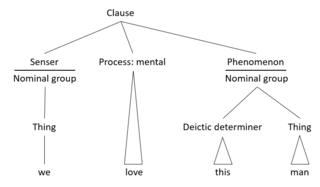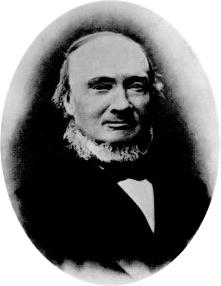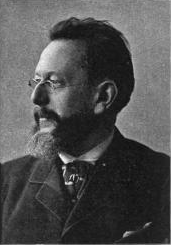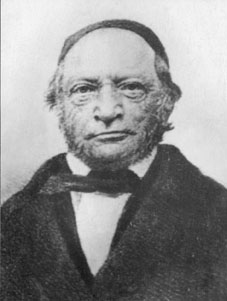
Functional linguistics is an approach to the study of language characterized by taking systematically into account the speaker's and the hearer's side, and the communicative needs of the speaker and of the given language community. Linguistic functionalism spawned in the 1920s to 1930s from Ferdinand de Saussure's systematic structuralist approach to language (1916).

Ivar Andreas Aasen was a Norwegian philologist, lexicographer, playwright, and poet. He is best known for having assembled one of the two official written versions of the Norwegian language, Nynorsk, from various dialects.

Norwegian is a North Germanic language spoken mainly in Norway, where it is an official language. Along with Swedish and Danish, Norwegian forms a dialect continuum of more or less mutually intelligible local and regional varieties; some Norwegian and Swedish dialects, in particular, are very close. These Scandinavian languages, together with Faroese and Icelandic as well as some extinct languages, constitute the North Germanic languages. Faroese and Icelandic are not mutually intelligible with Norwegian in their spoken form because continental Scandinavian has diverged from them. While the two Germanic languages with the greatest numbers of speakers, English and German, have close similarities with Norwegian, neither is mutually intelligible with it. Norwegian is a descendant of Old Norse, the common language of the Germanic peoples living in Scandinavia during the Viking Age.
Bokmål is an official written standard for the Norwegian language, alongside Nynorsk. Bokmål is the preferred written standard of Norwegian for 85% to 90% of the population in Norway. Unlike, for instance, the Italian language, there is no nationwide standard or agreement on the pronunciation of Bokmål.
Nynorsk is one of the two written standards of the Norwegian language, the other being Bokmål. From 12 May 1885, it became the state-sanctioned version of Ivar Aasen's standard Norwegian language parallel to the Dano-Norwegian written language (Riksmål). Nynorsk became the name in 1929, and it is after a series of reforms still a variation which is closer to Landsmål, whereas Bokmål is closer to Riksmål and Danish.

The Kodava is an endangered Dravidian language and it is spoken in Kodagu district in Southern Karnataka, India. The term Kodava has two related usages. Firstly, it is the name of the Kodava language and culture followed by a number of communities from Kodagu. Secondly, within the Kodava-speaking communities and region (Kodagu), it is a demonym for the dominant Kodava people. Hence, the Kodava language is not only the primary language of the Kodavas but also of many other castes and tribes in Kodagu. The language has two dialects: Mendele and Kiggat.

The voiceless alveolar lateral fricative is a type of consonantal sound, used in some spoken languages. The symbol in the International Phonetic Alphabet that represents voiceless dental, alveolar, and postalveolar lateral fricatives is, and the equivalent X-SAMPA symbol is K. The symbol is called "belted l" and is distinct from "l with tilde",, which transcribes a different sound, the velarized alveolar lateral approximant, often called "dark L".
The Language Council of Norway is the consultative body of the Norwegian state on language issues. It was established in 2005 and replaced the Norwegian Language Council which existed from 1974 to 2005. It is a subsidiary agency of the Ministry of Culture and has thirty-five employees. It is one of two organisations involved in language standardization in Norway, alongside the Norwegian Academy.
Dano-Norwegian was a koiné/mixed language that evolved among the urban elite in Norwegian cities during the later years of the union between the Kingdoms of Denmark and Norway (1536/1537–1814). It is from this koiné that the unoffical written standard Riksmål and the official written standard Bokmål developed. Bokmål is now the most widely used written standard of contemporary Norwegian.
Høgnorsk, is a term for varieties of the Norwegian language from Nynorsk that reject most of the official reforms that have been introduced since the creation of Landsmål. Høgnorsk typically accepts the initial reforms that, among other things, removed certain silent letters of etymological origin, while keeping most of the Landsmål grammar intact.

The Norwegian language conflict is an ongoing controversy in Norwegian culture and politics related to the written versions of Norwegian. From 1536/1537 until 1814, Danish was the standard written language of Norway due to the union of crowns with Denmark, in which time the Danish Empire was founded. As a result, the overall form of chosen modern written Norwegian and its leaning towards or away from Danish underpins controversies in anti-imperialistic nationalism, rural versus urban cultures, literary history, diglossia, spelling reform, and orthography.
Scandoromani is a North Germanic based Para-Romani. It is spoken by the Scandinavian Romanisæl Travellers, a Romani minority community, in Norway, and formerly in Sweden.

Henrik Mohn was a Norwegian astronomer and meteorologist. Although he enrolled in theology studies after finishing school, he is credited with founding meteorological research in Norway, being a professor at the Royal Frederick University and director of the Norwegian Meteorological Institute from 1866 to 1913.
Knut Bergsland was a Norwegian linguist. Working as a professor at the University of Oslo from 1947 to 1981, he did groundbreaking research in Uralic and Eskaleut languages.

Nils Joachim Christian Vibe Stockfleth was a Norwegian cleric who was instrumental in the first development of the written form of the Northern Sami language. Stockfleth compiled a Norwegian-Sami dictionary, wrote a Sami grammar and translated a portion of the Bible into the Sami language.

Alexander Bugge was a Norwegian historian. He was professor at the Royal Frederick University from 1903–1912, and his main fields of interest were culture and society in the Viking era and the development of trade and cities in Norway during the Middle Ages.

A Comprehensive Grammar of the English Language is a descriptive grammar of English written by Randolph Quirk, Sidney Greenbaum, Geoffrey Leech, and Jan Svartvik. It was first published by Longman in 1985.
Olav Toreson Beito was a Norwegian linguist and professor of Nordic studies at the University of Oslo.
Jan Terje Faarlund is a Norwegian linguist and professor emeritus of North Germanic languages at the University of Oslo.
Helge Kåre Fauskanger is a Norwegian author and philologist. In Norway he is known as a crime novelist; elsewhere, he is best known as a Tolkien scholar with an interest in Tolkien's constructed languages.










